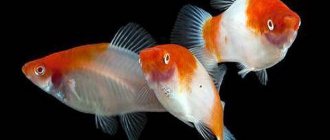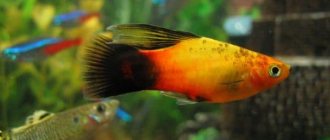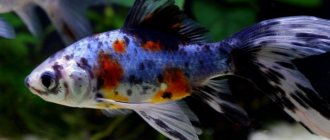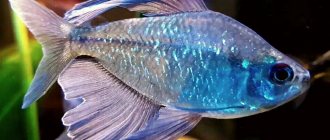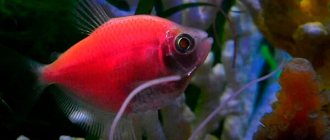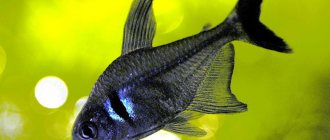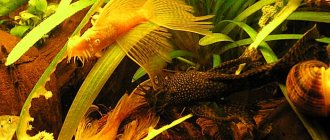Boesman's rainbow (Melanotaenia boesemani) Allen & Cross, 1980.
It appeared relatively recently in the decorative aquarium hobby, but has already managed to firmly establish itself in the hearts of hobbyists. Like all its relatives, it is unpretentious, peaceful, active, but most importantly, very beautiful.
Synonyms
English: Melanothenia Bosman, Atherina bicolor, Bicolor iris
Etymology
boesemani: named after the Dutch ichthyologist Marinus Boeseman, a collector of type specimens.
Order: Atheriniformes Family: Irises (Melanotaeniidae) Genus: Melanotaenia
Range and Habitat
Asia: It is endemic to the Ajamaru Lakes and their tributaries in the mountainous region of the Bird's Head Peninsula, West Papua, Indonesia.
It has a very limited distribution in nature, known only from three lakes known as Ayamaru of the Irian Jaya Peninsula and the nearby lakes Hain and Aitinyo.
Rainbowfish tend to congregate in the clear, shallow waters of lakes where aquatic vegetation is very dense. The lakes are characterized by very clear, hard and alkaline water (pH 8.0-9.0), and they also inhabit some adjacent tributaries with water chemistry indicators (pH 6.0-6.5).
Almost all of these fish come from fisheries in Asia and Eastern Europe. M. boesmani is actually quite rare in nature and is on the IUCN Red List as a critically endangered species.
Water requirements
If you are an experienced aquarist, then you have all the necessary tools to monitor the condition of the water. If not, then purchase a thermometer and instruments that will allow you to determine acidity and hardness. The ideal water for life of the Boesman's iris has the following values:
- the temperature should not fall below 21 degrees and rise above 26 degrees;
- pH (acidity) is a very important factor: it should be no lower than 6.5 and no higher than 8.0;
- dH (hardness) is much easier to track, since the data can vary from 8 to 25.
Description
The body is elliptical in shape, tall, laterally compressed. They have a very unusual shape of fins; the dorsal one consists of two parts, the first small and the second more elongated. The anal fin is symmetrical to the elongated part of the dorsal fin. The tail is forked, the head is narrow with large eyes.
The coloring of males is brighter and more expressive. The front half of the body is blue with a slight purple tint, gradually fading into blue bordering on the bright orange color of the rear half. In some individuals, the orange may take on a reddish or yellow-golden hue. Males have faintly visible dark stripes at the transition point of colors. The dorsal fins are orange with a greenish edging, the ventral fins are bluish, the anal fins are yellow with a blue edging. The females are not as showy and are entirely dark blue. But their silvery sheen is more visible.
In the absence of favorable conditions, the color fades and loses its attractiveness.
Size:
In an aquarium, males grow up to 11 cm, females are slightly smaller - about 8 cm.
Sex differences
Distinguishing the sexes of boesman's melanothenia is not easy, especially in young individuals.
Females are a couple of centimeters smaller in size and have a less bright color.
Males are larger, have more active behavior, the shape of the back is more curved, and the color is brighter.
Males can sort things out among themselves, so for peace in the aquarium you need to maintain the ratio of males and females.
Recommended proportions:
| Number of fish | Males | Females |
| 5 | same-sex | |
| 6 | equally | |
| 7 | 3 | 4 |
| 8 | 3 | 5 |
| 9 | 4 | 5 |
| 10 | equally | |
Skirmishes rarely have dire consequences, but you need to make sure that the males do not chase any one selected fish.
Behavior and Compatibility
They prefer the company of their own kind, but thanks to their peaceful disposition they get along well with comparable or slightly larger fish: tetras, sharks, zebrafish, discus fish, gouramis, bots and catfish.
Shrimp are also suitable as neighbors, but only such large species as Asian and African Filters and Amano. Small species of shrimp are mistaken for food.
They can also be compatible with many species of African cichlids due to their alkaline water conditions.
What to feed irises - melanothenium
The fish are not at all picky about food and eat a variety of foods, preferring live and frozen.
Please note that feeding Rainbowfish aquarium fish must be correct: balanced and varied. This fundamental rule is the key to successful keeping of any species of fish.
Therefore, it will be useful for you to read the article “How and how much to feed aquarium fish,” which describes this in detail, and also outlines the basic principles of the diet and feeding regime for fish.
At this time, dry food is, of course, popular and popular food for fish. For example, all the time and everywhere you can find food on aquarium counters - the leader of the Russian market, which has an assortment of food “for every taste.” Tetra’s “gastronomic arsenal” includes individual food for a specific type of fish: guppies, goldfish, cichlids, loricariids, labyrinths, arowanas, discus fish, etc. Tetra has also developed specialized foods, for example, to enhance color, fortified, or for feeding fry. You can find out detailed information about all Tetra feeds on the company's official website - here.
It would not be amiss to note that when purchasing any dry food, you should first of all pay attention to the date of its manufacture and shelf life, try not to buy food in bulk, and also store the food in a closed state - this will help to avoid the development of pathogenic flora in it
Aquarium
An active species, an aquarium with basic dimensions of 100 * 30 cm should be minimal - from 110 liters.
Undemanding and easy to adapt to new conditions. Considering that they prefer to live in a group of at least 6-8 individuals, preferably more, then all the colors and behavioral features are most clearly manifested. It is advisable to select an aquarium that is elongated in length.
Small-leaved species planted around the perimeter are suitable for plants so that there is free space for swimming. To prevent them from jumping out, the aquarium must be equipped with a lid.
Water parameters:
Temperature: 24 - 27° C pH: 6.5 - 9.0 Hardness: 5 - 20° dGH
Active aeration with filtration, weekly changes of a third of the water and good lighting are necessary. Water movement should be kept to a minimum.
Reproduction of iris boesmani
The spawning tank needs to be filled with plenty of vegetation and small leaves, and a good internal filter installed. Place a female ready for spawning in it, which previously ate abundantly on live food with the addition of vegetable food. This allows you to simulate the arrival of the rainy season, accompanied by a large amount of food. Place a male next to the female, who will mate with her and fertilize the eggs. We advise you to watch them, as the male will demonstrate a stunning show in front of his “betrothed” and his color will become very bright and saturated.
The spawning period lasts about two weeks. Throughout this time, every day the female lays eggs among the thickets of vegetation, using adhesive threads to attach them to the leaves. When you notice that the female begins to lay fewer eggs, it’s time to remove her from the spawning tank.
The duration of the incubation period is from a week to 12 days.
From the first days of life, fry can be fed with microfood such as ciliates or liquid food for fry. After just a week, the diet needs to be expanded with nauplii, Artemia and microworms. Creation date: 01/10/2017
Breeding
Propagation, small-leaved plants such as Java moss or synthetic threads in the form of a washcloth are placed in the spawning tank, the front glass is darkened, and overhead lighting is installed above the aquarium.
Water parameters in the spawning aquarium: 26-28 C, pH about 7.5, dH 6-7.
First, one or two females are released into the spawning area, and a few hours later two or three males. Producers should be fed with live daphnia, cyclops, and brine shrimp.
The female is capable of laying about 50 eggs daily. On average, the spawning process lasts about a week. After its completion, adult fish are removed, and constant aeration is ensured in the aquarium.
The larvae hatch in 7-12 days, depending on the temperature, and immediately begin to swim and feed, starting with rotifers and slipper ciliates, after a week or so they move on to Artemia nauplii. The fry must be fed frequently, but in small portions. About 10% of the water is changed several times a day. Sinking food is of little use; as a rule, the fry are very close to the surface of the water.
The fry can be released into the general aquarium when they reach a length of 3-4 cm.
When favorable conditions are created, the life expectancy in an aquarium is about 10 years.
Nutrition of Melanotaenia Boesemani
Under natural conditions, fish have a fairly wide variety of food, feeding on plants, fry, small crustaceans, and insects. Thanks to their omnivorous nature, there will be no problems feeding them in the aquarium. You can include both dry and live food in your diet. It is preferable to alternate their different types, since the body color of the Boesman’s iris also largely depends on nutrition.
Also, do not forget to diversify the diet with plant foods, such as lettuce or foods containing spirulina.
Notes
If you're looking to buy these rainbowfish, don't look for brightly colored fish like the ones in the photos! Adult specimens are rare and expensive; usually only faintly colored juveniles of these fish are on sale.
However, with some patience (even on a good diet, full color development can take over 12 months) and you will be rewarded with what is undoubtedly one of the most impressive tropical freshwater species available in the aquarium hobby.
General information
Rainbowfish (Melanotaeniidae) are a family of colorful freshwater fish found in Australia, New Guinea, Indonesia and a number of other islands and archipelagos separating the Indian and Pacific oceans.
The Latin name can be translated as “dark stripe,” and indicates a coloring feature - a stripe that appears to one degree or another in any iris.
Fish began to appear in hobby aquariums in the middle of the last century, but mass catching for sale significantly affected the size of natural populations. Nowadays, iris are bred in special farms, so the threat of extinction for many species has decreased.
Among the distinctive features of irises are the bright coloring of the body, the unusual, sometimes bizarre shape of the body and fins. The dorsal fin is forked in many species. The fish are peaceful, easy to keep, and can be kept in a common aquarium with most types of tropical fish. In nature they live in large flocks.

